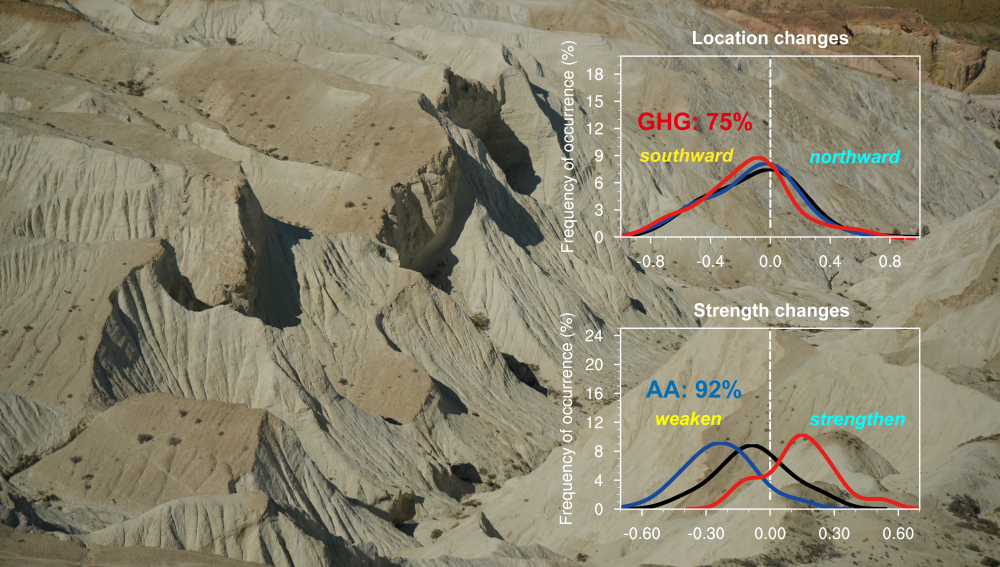中国科学院大气物理研究所大气科学和地球流体力学数值模拟国家重点实验室
State Key Laboratory of Numerical Modeling for Atmospheric Sciences and
Geophysical Fluid Dynamics (LASG)
Institute of Atmospheric Physics, Chinese Academy of Sciences
State Key Laboratory of Numerical Modeling for Atmospheric Sciences and
Geophysical Fluid Dynamics (LASG)
Institute of Atmospheric Physics, Chinese Academy of Sciences

Vol.15/No.15 April 2021
Human-induced Drying Trend in Central Asia since the 1950s
In a recently published research article in Geophysical Research Letters, JIANG Jie and ZHOU Tianjun from the Institute of Atmospheric Physics at the Chinese Academy of Sciences, highlighted the impacts of human activities on the fragile Central Asian ecosystem by influencing the key atmospheric circulation and local hydrological cycle.
The researchers found that the crisis of water resources shortage in northern Central Asia is also resulted from the drying trend since the 1950s. The decreasing rainfall trend is associated with the southward shift and weakening of the subtropical westerly jet. "The subtropical westerly jet is one of the important circulation systems in Eurasia and is closely linked to summer precipitation over NCA at different time scales," JIANG explained.

The changes in the location and strength of subtropical westerly jet under different forcings, which are associated with the drying trend over northern Central Asia. GHG: greenhouse gas-only historical simulation (red); AA: anthropogenic aerosol-only historical simulation (blue). (Image by JIANG Jie)
To identify and isolate the contributions of greenhouse gases, anthropogenic aerosols and natural forcings (including solar activity and volcanic aerosols) on the changes in SWJ and Central Asian precipitation, the researchers adopted the multimodel simulations of 10 models from the Detection and Attribution Model Intercomparison Project.
They demonstrated that the enhanced emission of greenhouse gases can contribute to an equatorial shift of the subtropical westerly jet, while increased Asian pollution and reduced European aerosol emissions can result in a weakened jet, both of which favor the descending motion and drying trend over northern Central Asia in summer since the 1950s.
"Our results show that human-induced emissions of greenhouse gases and aerosols in other regions of the world can also impact Central Asian precipitation and water resources by modulating the key atmospheric circulation," JIANG said.
This work is supported by Chinese Academy of Sciences and National Natural Sciences Foundation of China.
Reference: Jiang, J., and T. Zhou, 2021: Human-induced rainfall reduction in drought-prone northern Central Asia. Geophys. Res. Lett., 48, doi:10.1029/2020GL092156.
Link:https://agupubs.onlinelibrary.wiley.com/doi/epdf/10.1029/2020GL092156
Contact: ZHOU Tianjun, zhoutj@lasg.iap.ac.cn
Add: No.40, Huayanli, Beichen West Road, Chaoyang District, Beijing P.O. Box 9804, 100029, China
E-mail: lasg_newsletter@lasg.iap.ac.cn
Editors: Chuanyi Wang (wangcy@lasg.iap.ac.cn), Kangjun Chen(ckj@lasg.iap.ac.cn)
E-mail: lasg_newsletter@lasg.iap.ac.cn
Editors: Chuanyi Wang (wangcy@lasg.iap.ac.cn), Kangjun Chen(ckj@lasg.iap.ac.cn)